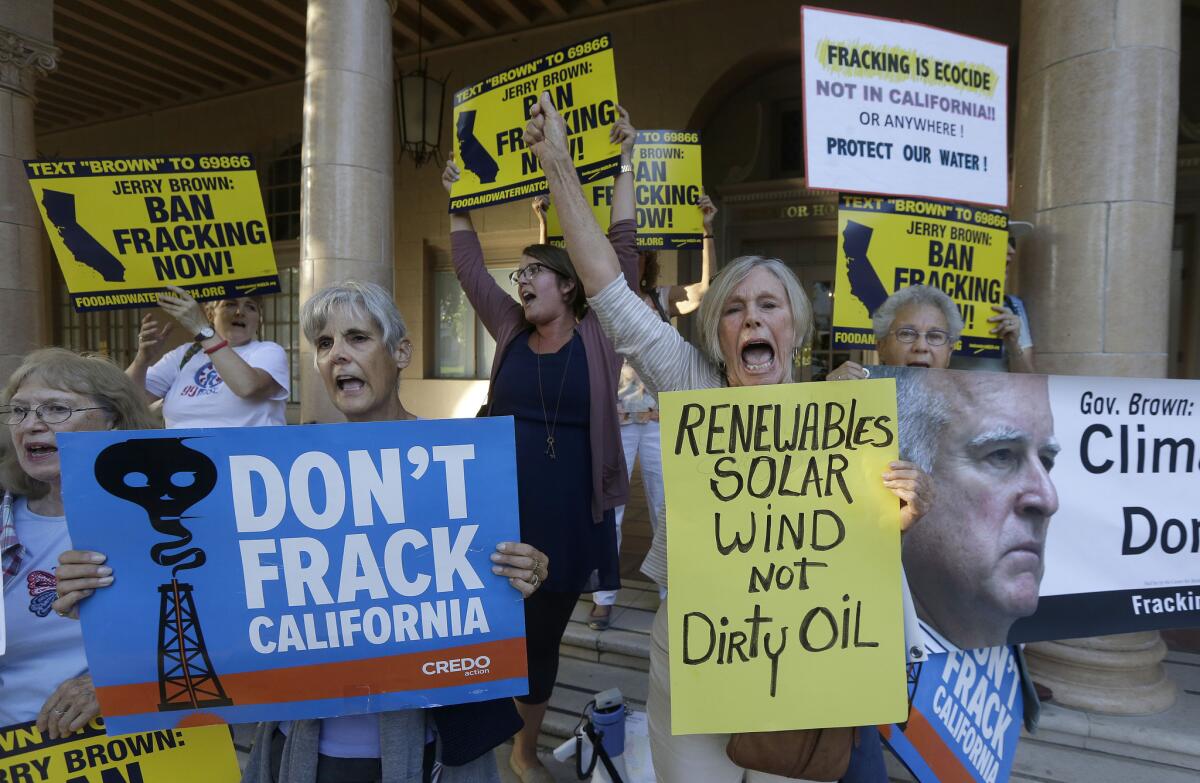Op-Ed: Gov. Jerry Brown’s fracking problem

- Share via
California Gov. Jerry Brown has done more to fight climate change than perhaps any other elected official in the United States. So what accounts for the environmentalists heckling him during speeches and planning to confront him Saturday at an Oakland March for Real Climate Leadership? One word: fracking.
“I challenge anybody to find any other state” that’s doing as much about climate change, Brown shot back to anti-fracking protesters during his speech at the California Democratic Party’s convention last March. California was on track to reduce carbon dioxide emissions by 25 billion tons by 2020, Brown accurately pointed out. The state will also obtain at least 33% of its electricity from solar, wind or other non-carbon fuels by then, he added.
Over the next 15 years, Brown declared in his inauguration speech in January, the share of California’s electricity produced from renewable energy will rise to 50%. Petroleum use by vehicles will
fall by the same percentage. Buildings will use energy twice as efficiently.
Joined by former Gov. Arnold Schwarzenegger, Brown has been hyping California’s bipartisan climate leadership as a model other governments should emulate by committing to ambitious emissions reductions at the make-or-break global climate summit in Paris in December.
But can Jerry Brown truly be a climate action champion if he does not reject fracking?
Oil and gas industry officials insist that the practice is safe and economically beneficial. They point out that fracking, notably in Texas and North Dakota, is largely responsible for the recent boom that has contributed to low gasoline prices and made the U.S. the world’s No. 1 producer of oil and natural gas.
Opponents dispute the safety argument and condemn diverting vast amounts of water to fracking amid California’s historic drought. (Fracking a single oil well can require 2 million to 8 million gallons of water that is then left too polluted for human or agricultural use.) Scientists have also concluded that fracking, which aims to shatter underground rock to free oil and gas, has helped cause earthquakes in Ohio and Oklahoma — no small consideration in California.
“People living next to these oil and gas operations are being hurt,” said Assemblyman Das Williams (D-Santa Barbara). Williams was commenting on on an analysis of health impacts released last month by a coalition of nurses, environmentalists and community leaders, which found that fracking exposes nearby residents to as many as 15 different toxic substances.
New York Gov. Andrew Cuomo recently banned fracking in his state after a review of its public health effects.
Meanwhile, the economic rationale for fracking in California suffered a crushing blow last May. That’s when federal officials slashed, by a whopping 96%, their estimate of how much recoverable oil there is in the Monterey Shale. Those are the underground deposits stretching from Kern County to Monterey, that industry analysts had said offered a bonanza of cheap oil for California.
For a self-proclaimed climate champion like Jerry Brown, though, the main problem posed by fracking should be its incompatibility with limiting future global warming to a survivable amount.
The governor is said to follow climate science, and the latest science (from the Intergovernmental Panel on Climate Change, the International Energy Agency and more) is clear. At least two-thirds of the Earth’s known reserves of fossil fuels must be left in the ground if temperature rise is to be limited to the internationally agreed (though arguably inadequate) goal of 2 degrees Celsius.
This two-thirds imperative rules out fracking almost by definition. Fracking is all about accessing the hardest to reach oil and gas deposits that can’t be extracted by conventional drilling.
Brown’s response to that fact? He says he takes a “pragmatic” view of the role of oil and gas in the economy. He no longer describes fracking the Monterey Shale as “a fabulous economic opportunity,” but he has not spoken out against fracking, much less banned it, as he could do through executive order.
In conventional political terms, it’s easy to see why Brown may prefer to avoid the fracking debate. He has many other priorities, and no chief executive can fight on all fronts at all times. Besides, there is relatively little fracking taking place in California at the moment, and low oil prices should keep it that way for the foreseeable future. Why pick a fight with the powerful oil and gas industry unless he has to?
Timing is crucial in politics, as Brown, one of the shrewdest wielders of power this state has ever produced, knows perfectly well. Is he simply waiting for the right moment to engage this controversy? Publicly, he has deflected fracking questions by saying he’s awaiting the results of a study of fracking’s economic, health and environmental implications that he and the Legislature ordered last year. It’s due July 1.
It’s hard to imagine Brown green-lighting a continuation, much less an expansion, of fracking in California. It seems more likely that he will wait until this summer and, citing the completed state study, declare that fracking has no place in California’s future.
But until he does, all claims of California exemplifying world-class climate leadership will have to come with an asterisk. Call it Jerry Brown’s frackterisk.
Mark Hertsgaard has reported on climate change for the New Yorker, Vanity Fair, Time, Bloomberg Businessweek and the Nation, where he is the environment correspondent. He is the author of six books including “Hot: Living Through the Next Fifty Years on Earth.”
Follow the Opinion section on Twitter @latimesopinion and Facebook
More to Read
A cure for the common opinion
Get thought-provoking perspectives with our weekly newsletter.
You may occasionally receive promotional content from the Los Angeles Times.









